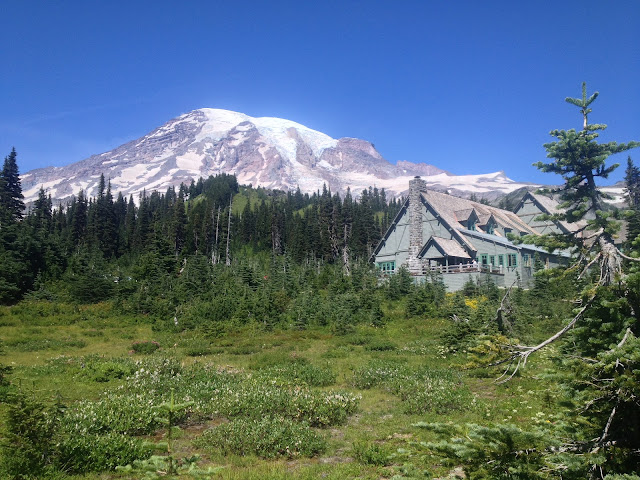Of all the fire mountains which, like beacons, once
blazed along the Pacific Coast, Mount Rainier is the noblest …” —John Muir
Mount Rainier is the fifth highest peak in the contiguous United States, and America’s fifth oldest national park. But for my family, we simply called this park home.
When my tour ended with the Department of Wildlife and National Parks in Botswana, Africa, Mountain Rainier National Park was my next assignment. It is a national park full of rich history, a crown jewel of America, and special to my wife and me. Our daughter, Lori, was born in the nearby town of Puyallup, WA. It was a magical time and place for our family.
Today I am riding my motorcycle from Central California across Oregon and nearly the entire state of Washington. My odometer reads 124,996 miles. I hope to remember the next few miles as another milestone approaches. At a scenic rest stop along Interstate 5, Mount Shasta stands tall in the distance. Another biker pulls up and we immediately make small talk.
“Where are you going?” he asks.
“Mount Rainier National Park.”
“How many miles?”
He is taken aback by my reply: “I don’t know.”
“Those are the best rides,” he says, strapping on his helmet. He is off to a wedding in Bend, OR. His wife will fly out from Los Angeles, and they plan to ride down Highway 101 back to LA. Who knows, I might see him again. Highway 101 has a magical ring to it. My route back home is uncertain, but he plants a seed among my mindless wanderings.
Thirty-seven years ago, we were stationed at Mount Rainier National Park when Mount St. Helens erupted. We were just 23 air miles away. The sight of that explosion was intense. Today, the regrowth of the forest is equally amazing. At the Mount St. Helens Visitor Center, I ask, “How many more miles to the Johnston Ridge Observatory?” “Well, about another 25 miles,” the clerk replies, “but if you have never seen Mount St. Helens up close, it is so rewarding.” When I describe the eruption we witnessed long ago, she looks me directly in the eyes and simply says, “That was 37 years ago. I see now that you have seen it.” Our son was six and our daughter was two at the time.
I’m a bit lost as I leave Interstate 5 for Mount Rainier National Park. The country roads are draped in heavy morning fog and the fast-moving logging trucks have me on high alert. It has been decades since I’ve been on these roads and I can’t remember a thing. The cold fog slows me down considerably. As I approach Elbe, an upcoming road sign is comforting: Mount Rainier National Park is just ahead!
In 1980, we lived at Tahoma Woods where I worked at Mount Rainier National Park for two-and-a-half years. I remember it rained a lot, but when the mountain was out, it was magical. The old, traditional Nisqually Entrance welcomes me just as the fog lifts. There are massive logs spanning the highway with heavy chains that support a large sign with the words “Mt. Rainer National Park” carved deep into the wood. The canyon follows the Nisqually River past Longmire to the alpine slopes of Paradise. There is a new visitor center at Paradise and people of all ages are leisurely exploring the mountain. The large lodges are dwarfed by its immensity.
Etched on granite steps is a perfect quote by John Muir:
“… the most luxuriant and the most extravagantly beautiful of all the alpine gardens I ever beheld in all my mountain-top wanderings.”
“… the most luxuriant and the most extravagantly beautiful of all the alpine gardens I ever beheld in all my mountain-top wanderings.”
Tomorrow, I will decide my route back home. I’ll think more about that biker’s comment. Perhaps Highway 101 south from Washington State will be a good choice, but that is another story. It’s been about 1,500 miles since leaving my home in Three Rivers, CA, and I must stop, really stop—stop to appreciate what is before me. After all, it has been 37 years.
A moment of silence, offering thanks, and appreciation. The mountain is on display in all its beauty, all in perfect harmony. The magic is still here. Then John Muir whispers in my ear: “The mountains are calling and I must go.”
Planning a Visit
Mount Rainier, ascending to 14,411 feet above sea level, stands as an icon in the Washington landscape and is 54 miles from Seattle. An active volcano, Mount Rainier is the most glaciated peak in the contiguous U.S., spawning six major rivers. Subalpine wildflower meadows ring the icy volcano while ancient forest cloaks Mount Rainier’s lower slopes. Wildlife abounds in the park’s ecosystems. A lifetime of discovery awaits. Over 97 percent of the park is wilderness—untrammeled, free from development; a place to explore, and to find solitude and wildness.There are three campgrounds at $20 per site: Cougar Rock (173 sites), Ohanapecosh (188 sites), and White River (112 sites). There are 10 primitive walk-in sites at Mowich Lake.GPS devices sometimes give inaccurate directions in this area, so keep a park map handy and pay attention to signs. Some roads are inaccessible in winter.To Do
Day hiking, Ranger-led activities, visitor centers and museums, skiing, snowshoeing, picnicking, horseback riding, camping, mountain climbing, wildflower viewing, the Longmire Historic District Walking Tour, and more.Hours
Open 24/7/365, weather permitting. Highest visitation is in July and August.Cost
$20 per motorcycle; $10 individual; $25 vehicle. All passes valid up to seven days for Mount Rainier National Park. Annual passes $50.For more information or to purchase a pass, visit www.nps.gov/mora.



No comments:
Post a Comment